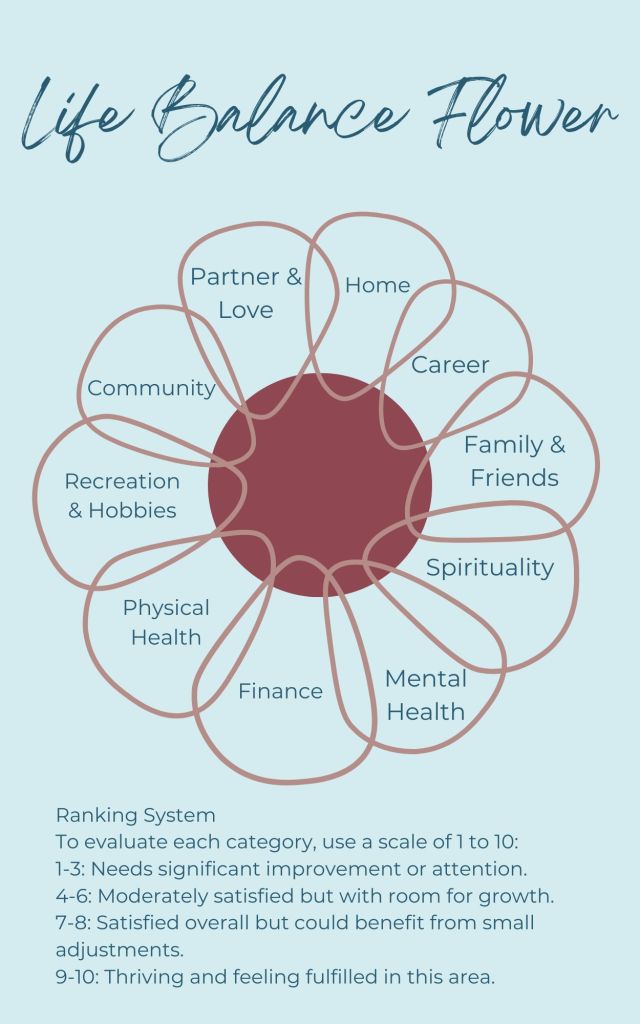Finding Balance with the Life Balance Wheel
- Amanda Fenker
- Jan 15
- 4 min read
Updated: Mar 25
As we embrace a new year filled with resolutions, aspirations, and the promise of a fresh start, it’s easy to feel both motivated and overwhelmed. Many of us set lofty goals, only to struggle with staying on track and end up feeling impatient with ourselves. Instead of aiming for a complete life transformation, I’ve found that a more balanced approach—using a Life Balance Wheel—helps me focus on what truly matters.
This simple yet powerful tool allows me to evaluate different areas of my life, pinpoint areas that need attention, and identify actionable steps to improve them. By taking this holistic approach, I’ve discovered how to stay aligned with my happiness and well-being while avoiding burnout. This doesn’t have to just be a New Year’s thing, it’s great to check-in on your Life Balance Wheel each month so you can assess which needs may be neglected. It’s not about perfection, life is messy and we will always struggle to stay balanced with all the different needs that face us in this human life. But this tool does allow us to easily check-in on what areas may be feeling neglected so we can give them more of an effort.
How the Life Balance Wheel Works
The Life Balance Wheel consists of various categories representing different aspects of life. Each category is rated on a scale of 1 to 10 based on how satisfied you currently feel with that area. After assessing your rankings, you can reflect on why certain areas might feel lower and brainstorm ways to improve them. Since life is ever-changing, your scores will be too!
Some adjustments may be simple—maybe you don’t have a huge budget for house renovations at the moment but are feeling uninspired in your living space. Something like adding some plants to your home environment could boost your score a bit—while others might be more complex, such as dedicating time to building financial literacy, a project that may come with a learning curve and some trauma healing. Regardless of the effort involved, this process provides a clear picture of where you stand and empowers you to make intentional changes.
Categories for Your Life Balance Wheel
Here are the categories I use to evaluate my life balance. Feel free to customize this list to suit your needs:
Family and Friends: The quality of your relationships and time spent with loved ones.
Spirituality: Your connection to your inner self, beliefs, or spiritual practices in whatever way that means to you.
Mental Health: Your emotional well-being and ability to manage stress and challenges.
Career: Your satisfaction with your work and professional growth. Even if you are retired are in a stay-at-home parent phase, no matter the situation, what does “career” currently mean to you?
Finance: Your comfort and knowledge about managing money and financial goals.
Community: Your sense of belonging and contribution to your community. This may be different than friends & family. Maybe you join a pickleball league or a pottery class.
Recreation & Hobbies: How often you engage in activities that bring joy and relaxation.
Partner & Love: The health and connection in your romantic relationships – even if that is currently focused on self-love!
Home: The comfort, organization, and atmosphere of your living space.
Physical Health: Your overall health, fitness, and energy levels.
If you feel that something important is missing, don’t hesitate to add your own category. For example, I’ve included “Partner & Love” because it’s valuable for me to reflect on my relationship and how I can nurture it. Adding categories doesn’t mean you have to take away from others—there’s always room to expand the circle!
Ranking System
To evaluate each category, use a scale of 1 to 10:
1-3: Needs significant improvement or attention.
4-6: Moderately satisfied but with room for growth.
7-8: Satisfied overall but could benefit from small adjustments.
9-10: Thriving and feeling fulfilled in this area.
Reflection and Action Steps
Once you’ve ranked each category, take some time to reflect. Ask yourself:
Why might certain areas feel lower than others?
What actionable steps can I take to improve these areas? Stay tuned for a future post on some of our ideas!
What strengths or resources do I already have that can help?
For example:
If “Home” feels low, consider decluttering or adding cozy elements like plants or lighting.
If “Finance” is a challenge, commit to learning one new financial skill each month.
A Balanced Life, Not a Perfect One
The beauty of the Life Balance Wheel is its flexibility and gentle approach. It’s not about perfection but about creating a life that feels balanced and fulfilling. While goal-setting remains essential, starting with a big-picture overview helps ensure that no area of life gets left behind.
So, as you step into this new year, remember: You are complex, multi-faceted, and deserving of grace. More frequent trips to the gym are rarely a fix-all so try to remember there are other reasons you may be feeling down and be gentle with yourself! Take it one step at a time, and let the Life Balance Wheel guide you toward greater harmony and joy.
How do you find balance in your life? We’d love to hear your thoughts or tips in the comments below!

.png)




Comments